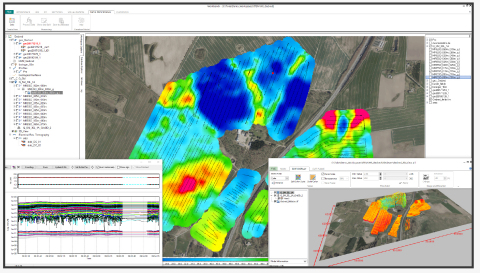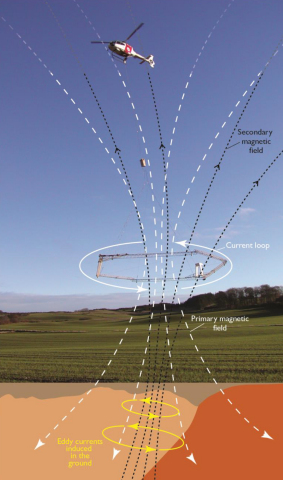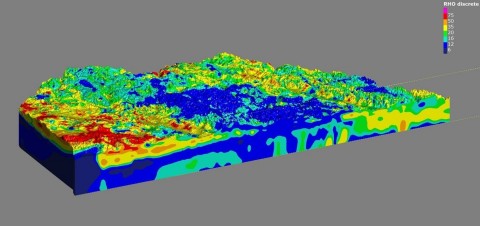EXTON, Pa.--(BUSINESS WIRE)--Bentley Systems, Incorporated (Nasdaq: BSY), the infrastructure engineering software company, today announced that its Seequent business unit has acquired Danish company Aarhus GeoSoftware, a developer of geophysical software. The acquisition extends Seequent’s solutions for operational ground water management, and for sustainability projects involving exploration, contaminants, and infrastructure resilience.
Aarhus GeoSoftware, a spinoff company from Aarhus University in Denmark, develops the software packages AGS Workbench, SPIA, Res2DInv, and Res3DInv for the processing, inversion, and visualization of geophysical data from ground-based and airborne electromagnetic (EM), electrical resistivity tomography (ERT) remote sensing, and other sources. AGS software enables users to create 2D and 3D images of subsurface electrical resistivity. The outputs of the software can be used to distinguish and differentiate subsurface materials and can subsequently be modeled in Seequent’s Leapfrog to aid in various subsurface investigations.
The software uses electric field measurements, collected at ground level or with airborne sensors, to map the subsurface distribution of certain materials such as water, mineral deposits, and clays. Electrical resistivity allows a better understanding of the distribution of materials such as water, mineral deposits, and clays, and when the water contains other compounds such as salt, researchers and industry professionals can infer the distribution.
The genesis of AGS software was to ensure clean drinking water for future generations by mapping groundwater across Denmark. It is now used in many different areas, including locating subsurface faults and cavities to mitigate construction risk, in mining for investigating orebodies and waste rock and tailing processes, monitoring movements of groundwater and contaminants to help understand environmental impacts, modeling dam and tunnel stability, and assessing landslide risk to gauge asset resilience or construction plan impacts. Seequent will continue its tradition of collaborating with universities and research organizations worldwide through ongoing engagement with Aarhus University for the development of AGS geophysical solutions.
Graham Grant, chief executive officer of Seequent, said, “The acquisition will add new geophysical data processing capabilities to our workflows to help advance subsurface investigation and modeling. AGS software, coupled with Seequent’s advanced geologic modeling and analysis software, creates a key tool in helping understand and manage groundwater and assessing risk in infrastructure such as dams and canals. We’re excited about the new possibilities this opens up for our collective users worldwide, improving life-time digital twins.”
Toke Højbjerg Søltoft, chief executive officer of Aarhus GeoSoftware, said, “Seequent’s global reach will allow AGS software to positively impact more projects worldwide. As we continue to develop solutions, our users will benefit from our tools being in Seequent’s ecosystem and workflow. We’re excited to join Seequent and to work together on our shared vision of helping organizations make more informed and sustainable decisions through a better understanding of the subsurface.”
For more information, please visit https://www.aarhusgeosoftware.dk/.
Image 1: https://www.bentley.com/-/media/Images/Press%20Release%20Images/2021/Aarhus_Workbench
Caption: AGS Workbench is a comprehensive software package for processing, inversion, and visualization of geophysical and geological data. The AGS Workbench package is based on a GIS interface and includes dedicated data processing modules for various geophysical data types. The package integrates all workflow steps from processing the raw data to the final visualization and interpretation of the inversion models.
Image 2: https://www.bentley.com/-/media/Images/Press%20Release%20Images/2021/Aarhus_Workbench_TEM_Workflow
Caption: Airborne Electromagnetic (AEM) remote sensing is used to collect extensive volumes of data from an aircraft. A sensor loop below a helicopter or small plane transmits an electromagnetic signal to the earth. Based on the subsurface properties, a secondary field is created and measured at the aircraft. These data are then processed to estimate subsurface electrical properties. The AGS Workbench software is used for processing, inversion, and visualization of the data collected by AEM and other geophysical methods.
Airborne Electromagnetic (AEM) remote sensing uses electromagnetic induction to collect extensive volumes of data from an aircraft. It is a fast and cost-effective way of subsurface mapping, can cover large areas (10s-1000s of km2) in a few days, requires no new drilling or ground access, and, using 3D modeling and visualization software, has a quick turnaround for mapping the subsurface.
The technique involves a helicopter or a small airplane towing a sensor loop approximately 100 feet (30 meters) above the ground. This generates an electromagnetic signal transmitted into the earth based on the subsurface properties, thereby a secondary field is created and measured at the aircraft. These data are then processed to estimate subsurface electrical properties. Depending on resistivity or conductivity, the returned signal helps geoscientists establish the nature of the subsurface.
Image 3: https://www.bentley.com/-/media/Images/Press%20Release%20Images/2021/AEM_slice
Caption: Sensing data processed and inverted in AGS Workbench software can then be combined in Seequent’s Leapfrog Works to create a 3D model that gives a detailed overview of resources. The above image is a hydrogeological map of the subsurface of the Principal Aquifer (and parts of the Ogallala Aquifer) in Nebraska, United States. Airborne Electromagnetic (AEM) remote sensing was used to capture data from the 4,000-square-mile study area. The color-coded volumes represent eight resistivity categories. Higher resistivity values are represented as yellow to red (sand and gravel), lower resistivity values are represented as blue to green (clay and silt), and brown represents bedrock.
About Seequent
Seequent, a Bentley company, is a world leader in the development of powerful geoscience analysis, modeling, and collaborative technologies for understanding geoscience and engineering design solutions. Our solutions enable people to analyze complex data, manage risk, and ultimately make better decisions about earth, environment, and energy challenges.
Seequent software is used on large-scale projects globally, including road and rail tunnel construction, groundwater detection and management, geothermal exploration, subsea infrastructure mapping, resource evaluation, and subterranean storage of spent nuclear fuel.
Seequent’s global footprint includes its Christchurch-based HQ and R&D centers in Christchurch and Canada, with a network of offices across Asia/Pacific, Africa, South America, North America, and Europe servicing organizations with leading subsurface solutions in over 100 countries. For more information, please visit www.seequent.com or follow Seequent on LinkedIn or Twitter.
About Bentley Systems
Bentley Systems (Nasdaq: BSY) is the infrastructure engineering software company. We provide innovative software to advance the world’s infrastructure – sustaining both the global economy and environment. Our industry-leading software solutions are used by professionals, and organizations of every size, for the design, construction, and operations of roads and bridges, rail and transit, water and wastewater, public works and utilities, buildings and campuses, and industrial facilities. Our offerings include MicroStation-based applications for modeling and simulation, ProjectWise for project delivery, AssetWise for asset and network performance, and the iTwin platform for infrastructure digital twins. Bentley Systems employs more than 4,000 colleagues and generates annual revenues of more than $800 million in 172 countries. www.bentley.com
© 2021 Bentley Systems, Incorporated. Bentley, the Bentley logo, AGS Workbench, AssetWise, iTwin, Leapfrog, MicroStation, ProjectWise, Res2DInv, Res3DInv, Seequent, and SPIA are either registered or unregistered trademarks or service marks of Bentley Systems, Incorporated or one of its direct or indirect wholly owned subsidiaries. All other brands and product names are trademarks of their respective owners.







